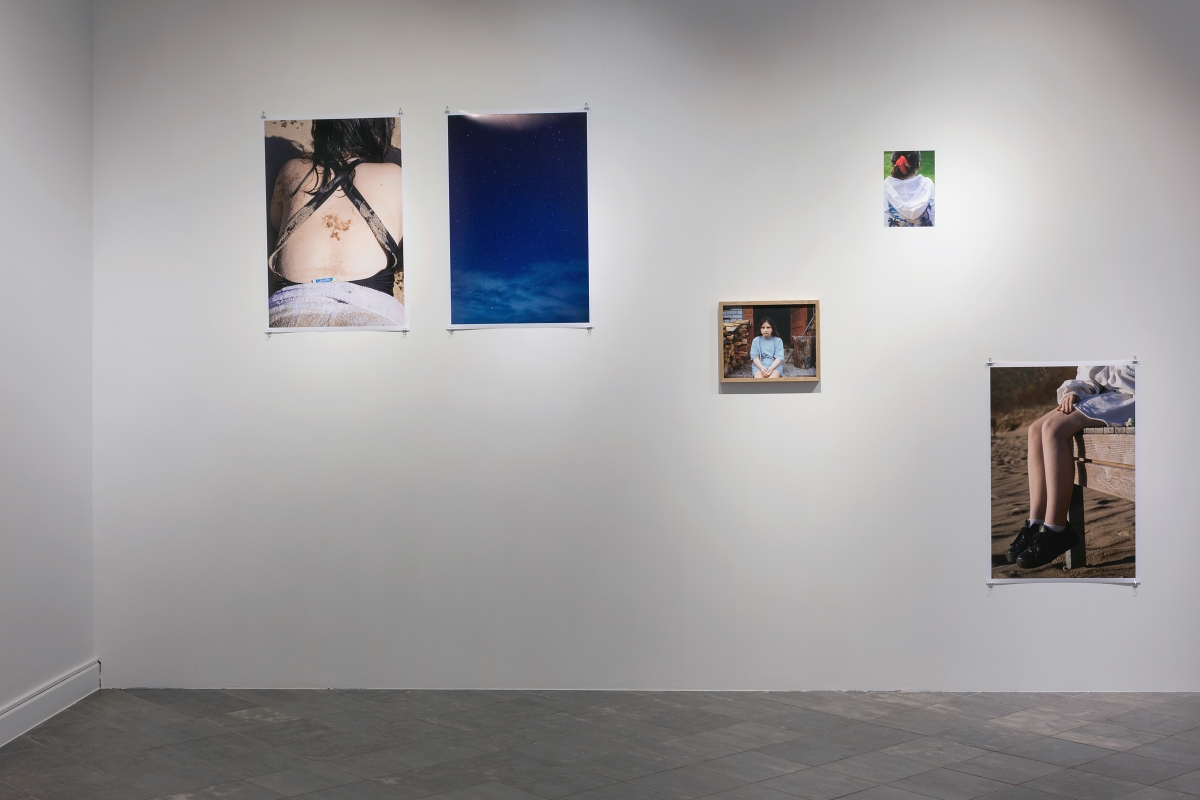Half-Love explores the relationship between the artist Diana Tamane and her younger half-sister Elina. Exhibited here for the first time, this new body of work continues a long line of projects focused on her family, in which since 2010 Tamane has collaborated with members of her extended family, with photography at the heart of the conversation.
Beginning in 2008, the year of her sister’s birth, Tamane began taking photos of their shared time together. This ongoing project, when viewed in retrospect, traces the life of Elina from birth to the spring of 2022.
Separated for most of the year because they live in different countries, Tamane in Estonia and Elina in Latvia, the project is centred around the family’s summer house in Vārzas, Latvia. Located 64 km from Riga, Vārzas, also known as Kursīši, is a village of around 400 summer houses developed for the workers of the VEF (State Electrotechnical Factory). Tamane’s maternal and paternal grandmothers both worked at the factory and in 1981 the family acquired a summer house. A place of deep significance for the artist, she returns to Kursīši each year to spend the summer with family, including her sister.
The use of this one fixed location in the project means the passing of time is evident both visually and metaphorically throughout the body of work, and several reoccurring motifs emerge. The greenhouse appears as a makeshift studio where each year a traditional portrait is taken, creating a timeline as Elina grows older. The physical greenhouse structure remains unchanged, a fixed point of reference, although the plants inside change and grow, as does Elina. These greenhouse portraits are shown sequentially, from the earliest image to the most recent. This traditional mode of presentation references the artist’s classic approach to photographic portraiture in these images, while allowing the viewer to note the incremental growth on the wall.
Other reoccurring motifs also appear throughout the space, including the view of the neighbouring forest taken from the balcony of the summer house. Cut down in 2015 and presumably sold as lumber, the regrowth of the forest mirrors the passing of years. A beach also appears throughout the series: sand, the horizon, sunsets, constantly moving yet unchanged, a metaphor for rejuvenation and new beginnings, all adding to the cycle of time. Utilising a different curatorial approach, these images are scattered throughout the exhibition; with small, sometimes hardly recognisable changes, these images, particularly those of the forest, evoke a feeling of deja vu.
In this long-term project, portraits are interspersed with landscapes and still lifes. Interior details, such as vases, flowers, a radio and a writing desk, help to shape the mood of the series. Outdoor studies of freshly picked apples, cucumbers and tomatoes are seen in close up, swarming with insects, including butterflies, bathed in sunshine: this is what summer in Kursīši looks like.
Unlike much of Tamane’s work, which follows an often rigid conceptual pattern in terms of image making, this project is a mix of traditional portraiture and experimental documentation, the latter injecting the exhibition with moments of spontaneity. Elina as a young child seems to almost perform for the camera while eating ice cream at the beach. Years later she is captured deep in conversation with her friend, perhaps at the same beach location. The exhibition installation also reflects these two approaches, beginning with a relatively traditional hanging of works and moving towards a more experimental installation, as the viewer moves through the exhibition space.
Photography’s beauty lies in its ability to simultaneously freeze and stretch time. Here Elina’s life can be seen as individual moments and as one long journey. This allows for reflection and an appreciation of life, capturing the speed with which things change. This ongoing willingness of Elina to participate in the collaboration is testament to the close bond between the two sisters. For Tamane, the project and the process are both an observation and a love letter, a chance to give advice and to relive some of her own childhood experiences from a different perspective, all in a location which is sacred and familiar.
Text by Shoair Mavlian, Director of Photoworks
She has had solo exhibitions at the Contemporary Art Museum of Estonia (2022), Kogo gallery (2022), Narva art residency (2021), De Vereniging, S.M.A.K. (2020), ISSP Gallery (2020, 2018), Surplus Art Space (2017), Kim? Contemporary Art Center (2016). Tamane has participated in the Kyiv Biennial (2021), the festival Survival Kit 10.1 (2019), the 1st Riga International Biennial of Contemporary Art (2018) and the Kathmandu Triennial (2017).Shoair Mavlian (Armenia/ Australia/ UK, 1984) is Director of Photoworks. Recent Photoworks projects include Photoworks Festival: Propositions for Alternative Narratives (2020) and Ursula Schulz-Dornburg, Zone Grise/The Land In between (MEP, Paris 2019).
From 2011 to 2018 Mavlian was Assistant Curator, Photography and International Art at the Tate Modern, London, where she curated the major exhibitions Don McCullin (2019), Shape of Light: 100 Years of Photography and Abstract Art (2018), The Radical Eye: Modernist Photography from the Sir Elton John Collection (2016), Conflict, Time, Photography (2014), A Chronicle of Interventions (2014) and Harry Callahan (2013). While at the Tate Modern, she helped build the photography collection and curated collection displays enjoyed by over five million visitors per year.
Mavlian has a background in fine art photography practice and the history of photography, with a focus on conflict and memory, and emerging contemporary practice. In 2018, she was named one of Apollo Magazine’s “40 under 40 Europe – Thinkers”.
Exhibition title: Half-Love
Artist: Diana Tamane
Curator: Shoair Mavlian
Exhibition venue: Tartu Art Museum, Estonia
Exhibition dates: 18.06.2022 – 16.10.2022











































































